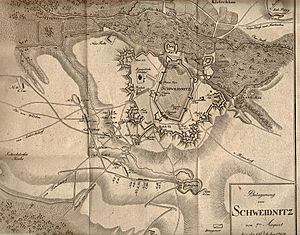Siege of Schweidnitz (1762) facts for kids
Quick facts for kids Siege of Schweidnitz |
|||||||
|---|---|---|---|---|---|---|---|
| Part of the Third Silesian War (Seven Years' War) | |||||||
 |
|||||||
|
|||||||
| Belligerents | |||||||
| Commanders and leaders | |||||||
| Frederick II of Prussia Friedrich Bogislav von Tauentzien Duke of Bevern |
Franz Guasco Leopold Joseph von Daun |
||||||
| Strength | |||||||
| 25,000 | 10,000 | ||||||
| Casualties and losses | |||||||
| 3,033 killed and wounded |
10,000 3,552 killed and wounded 9,000 captured(including the wounded) |
||||||
The Siege of Schweidnitz was an important event that happened between August and October 1762. It was part of the Third Silesian War, which was itself a part of the bigger Seven Years' War. During this siege, the army of Prussia, led by Frederick II, tried to take back the city of Schweidnitz from the Austrian soldiers who were holding it.
Contents
Why Schweidnitz Was Important
Schweidnitz was a very important city for Prussia in the region called Silesia. Think of it as a key spot on a map. It was in the middle of everything and had large storage areas for supplies. The year before, Austrian forces had captured the city. Austria wanted to keep Schweidnitz. They hoped it would give them a strong position if there were peace talks. But Frederick II of Prussia was determined to get it back. He saw a chance to attack again because Russia and Sweden had left the war.
The Siege Begins
Frederick's army first cut off Schweidnitz from the main Austrian army. This main army was led by Leopold Joseph von Daun. On August 9, 1762, the Prussians started their attack. They began to bombard the city with cannons. Frederick sent a group of soldiers, led by Duke of Bevern, to a place called Reichenbach. From there, Duke Bevern stopped Daun's attempts to march and help the city. This fighting caused about 1,000 casualties.
Fighting Continues
Six days after the Austrians failed to help, the commander of Schweidnitz offered to give up the city. However, Frederick said no to his terms. The Austrian commander wanted his soldiers to be allowed to march away with "honours of war." This meant they would leave with their weapons and flags. But Frederick demanded that the entire Austrian army surrender as prisoners of war. So, the siege continued. In September, Frederick even threatened to kill the soldiers if they did not surrender right away. The Prussians also stopped another big effort by Daun to help the city.
The City Falls
On October 8, something big happened. Prussian soldiers had dug a mine under the city. This mine exploded the Austrian army's gunpowder storage. The very next day, Schweidnitz finally gave up. Both sides had lost about 3,000 soldiers during the two-month siege. The Austrian Empress Maria Theresa was proud of how long her soldiers had fought. She promoted their leaders and rewarded all the soldiers after they were released.
What Happened Next
The capture of Schweidnitz, along with a Prussian victory at the Battle of Freiberg, were some of the last major events of the war. A peace agreement was signed in early 1763. This agreement was called the Treaty of Hubertusburg. It confirmed that all of Silesia would return to Prussia.

